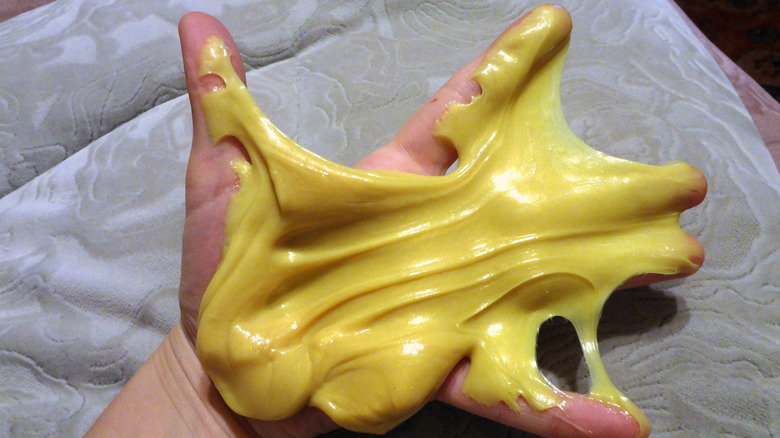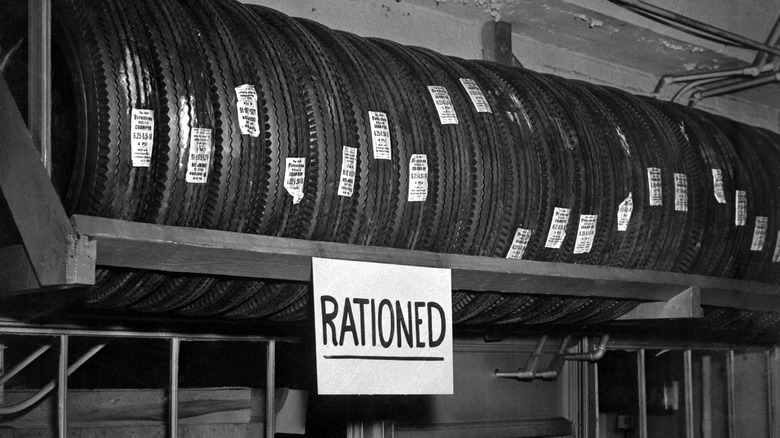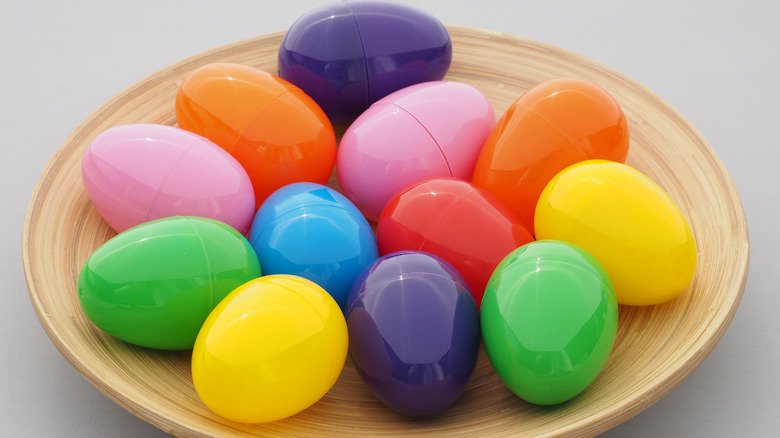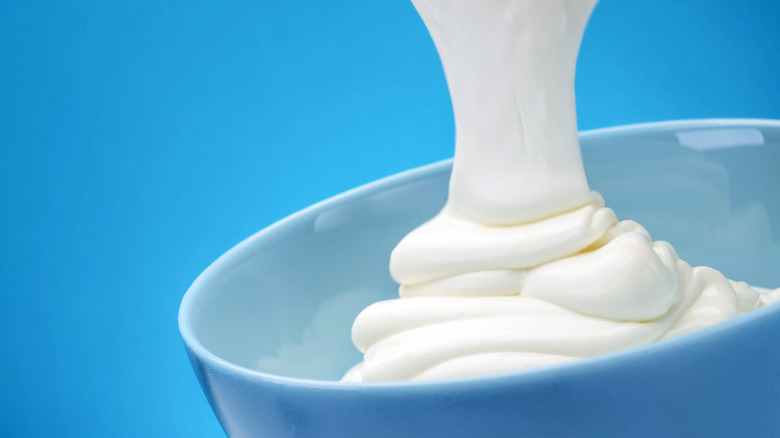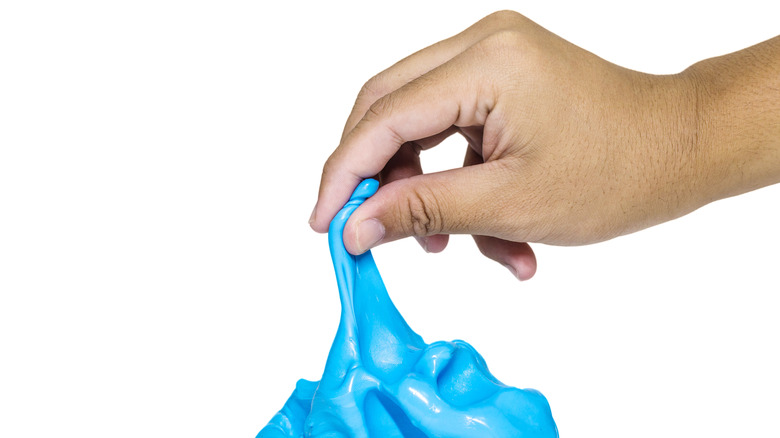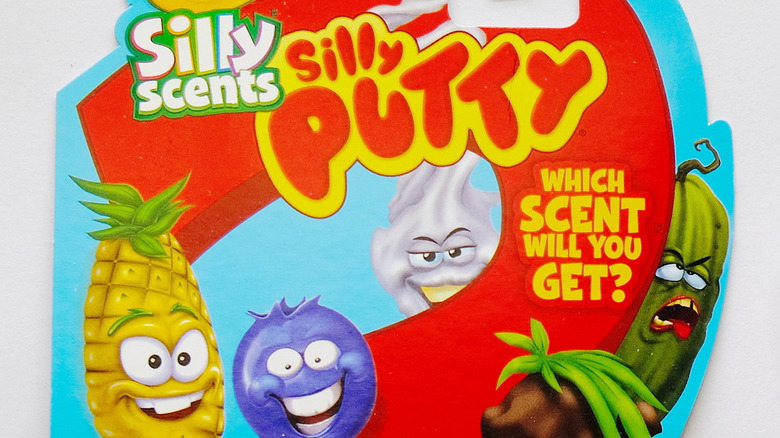What Happened To Silly Putty?
When it comes to amazing goo that provides hours of entertainment, there isn't anything quite like Silly Putty. Available in plastic eggs, it's not a typical toy, but you can play with it. In fact, the many ways Silly Putty can be manipulated seem endless, and that may be why it is so popular. If you're old enough, you might remember applying Silly Putty to comic strips and other parts of the newspaper to copy the text and images, which you could then twist and distort.
Silly Putty might be geared more toward kids these days, but that wasn't always the case. Mental Floss explains that adults were targeted when it was presented at the 1950 International Toy Fair. Over the years, it seems Silly Putty has captured the attention of both. It has even earned a permanent spot at the National Museum of American History because it is a "case study of invention, business, and entrepreneurship." But how did this strange material come to be, and what became of it?
Silly Putty was invented accidentally
Silly Putty was not the result of someone sitting around thinking of a way to delight kids across the globe. Rather, it was invented by accident during World War II. According to Science History, Silly Putty's story begins with a need for rubber due to a shortage created when the Allies were cut off from their supply in Indonesia and Southeast Asia. Rubber was needed to make a variety of items including tires, boats, tanks, and planes. Looking for help to come up with a substitute, the government reached out to scientists, asking them to get creative.
Chemists Earl Warrick and James Wright began to experiment, and one of the compounds they made was a mixture of silicone oil and boric acid. The substance was not an adequate replacement for rubber, but it was fun to mess with, and Warrick and Wright showed it to their friends who showed it to their friends.
An advertiser propelled Silly Putty to fame
One of the people who became interested in Warrick and Wright's putty was toy store owner, Ruth Fallgatter. In 1949, she showed it to advertiser Peter Hodgson, who happened to love toys. Science History reports that Fallgatter carried the "bouncing putty" in her store for a while, but eventually stopped stocking it.
Hodgson saw an opportunity when she discontinued selling it, and borrowed money to buy a batch of it for himself. He called it "Silly Putty," and in 1950, he came up with the idea of selling it in plastic eggs just in time for Easter. He persuaded Doubleday and Nieman-Marcus bookstores to carry the product, but it never garnered much attention. That is, until a reporter for the New Yorker stumbled upon the product one day, and wrote an article raving about it. Before long, Silly Putty became a national sensation. Within a year, Hodgson sold millions of eggs filled with Silly Putty, and by the '70s, sales topped $5 million.
Silly Putty is a non-Newtonian fluid
No doubt about it, Silly Putty is just plain weird. If it strikes something fast and really hard, it will shatter, like something solid. However, if you pull on it slowly, it stretches like soft rubber. It belongs to a specific group of compounds known as non-Newtonian fluids. These materials get their name because they do not conform to Isaac Newton's definition of an "ideal liquid." Water is an example of how an ideal liquid would behave but some fluids act nothing like water.
Simply put, Scientific American explains non-Newtonian fluids are different from ideal liquids due to how their viscosity changes in relation to "shearing force." There are several examples of non-Newtonian fluids, and while some may resemble water, others are more like Silly Putty. For example, ketchup, mud, blood, pudding, thick pie fillings, gravy, quicksand, and yogurt are examples of non-Newtonian fluids.
Silly Putty is more than a toy
While kids might find Silly Putty fun to play with, it has other interesting uses. Mental Floss reports that astronauts on Apollo 8 took some to space with them in 1968, and used it as a way to hold down tools in zero gravity. The Columbus Zoo found a creative purpose for Silly Putty when they used it to make casts for gorilla paws. Some athletes use it to strengthen their grip.
But its uses don't stop there. According to Wacky Uses, you can use it to clean lipstick stains from fabric just by pressing it onto the stain. You can use it in the same way to remove dirt, debris, and hair from keyboards, crevices, and furniture. Keep in mind, however, your putty will hold onto the objects it picks up. You can also relieve stress by squeezing it in your hands.
Silly Putty is still popular
Crayola bought the Silly Putty company after Hodgson passed away, per Metal Floss. The product is as popular today as it was some 70 years ago. In fact, it is a top-selling toy with more than 300 million eggs sold.
While the $1 price tag remains the same, you won't get as much of the goop in one egg as you could in 1950. When Silly Putty hit the market, the egg had one ounce of putty in it. Today, an egg only contains half of an ounce. The original product has undergone some aesthetic changes, but the texture remains the same. The original putty was a pinkish-beige color, but now you can find it in a variety of colors. You can even find scented Silly Putty, a softer, fluffier "cloud" version, and an ugly, green "puke" putty that includes red silicone chunks (via Crayola).
